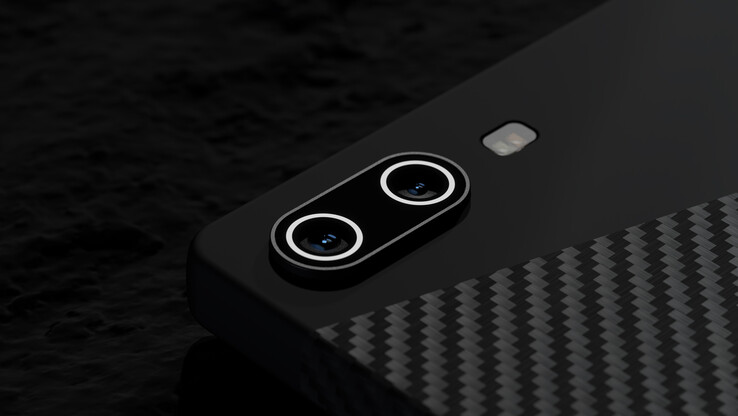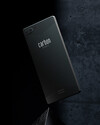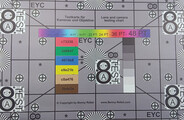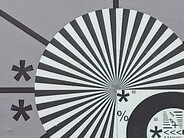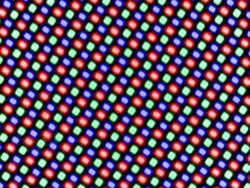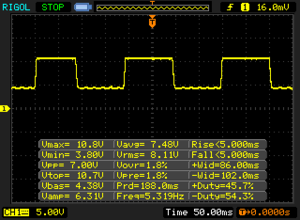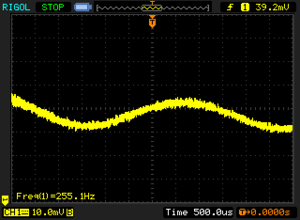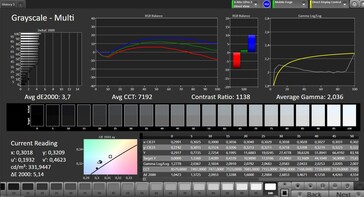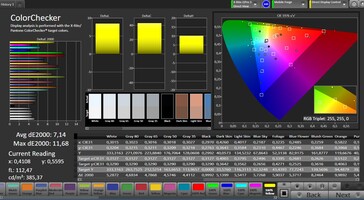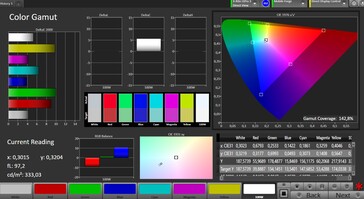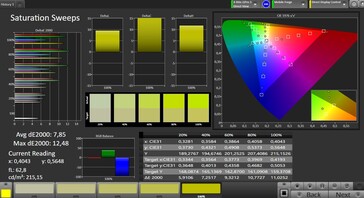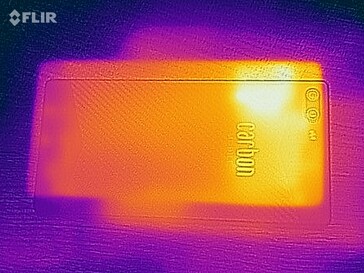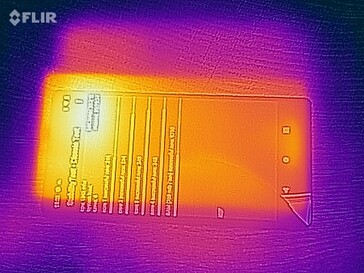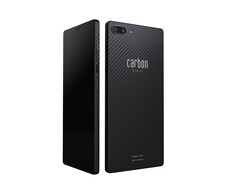Carbon 1 Mk II smartphone review - Innovative, light and outdated
Possible competitors in comparison
Rating | Rating Version | Date | Model | Weight | Drive | Size | Resolution | Price from |
|---|---|---|---|---|---|---|---|---|
| 79.5 % v7 (old) | v7 (old) | 05 / 2021 | Carbon 1 Mk II Helio P90, PowerVR GM9446 | 125 g | 256 GB UFS 2.1 Flash | 6.01" | 2160x1080 | |
| 88.2 % v7 (old) | v7 (old) | 11 / 2020 | Apple iPhone 12 A14, A14 Bionic GPU | 162 g | 64 GB SSD | 6.10" | 2532x1170 | |
| 89.5 % v7 (old) | v7 (old) | 02 / 2021 | Samsung Galaxy S21 Exynos 2100 5G, Mali-G78 MP14 | 169 g | 128 GB UFS 3.1 Flash | 6.20" | 2400x1080 | |
| 86.6 % v7 (old) | v7 (old) | 11 / 2020 | Sony Xperia 5 II SD 865, Adreno 650 | 163 g | 128 GB UFS 3.0 Flash | 6.10" | 2520x1080 |
Case, features and operation - Low weight
Why do smartphones always have to be made of plastic? Or made of metal and glass? That's exactly the question the start-up Carbon Mobile asked itself and quickly found the answer: A large number of radio signals must be able to pass through the material to the outside: Be it for mobile communications, WLAN, positioning or near-field communication. And only a few materials are really suitable for this purpose.
Carbon is not really one of them. So they worked on it until they found their own, radio-capable carbon composite material and used it to build a very light yet robust smartphone: The Carbon 1 Mk II from Carbon Mobile, which we will take a look at in this review.
The casing is quite compact with a 6.01-inch screen and surprisingly light at 125 grams. However, you also have to take into account the significantly smaller battery in view of most comparison devices. We like the fact that Carbon Mobile moves away from the standard design with rounded corners and presents an angular smartphone that also looks chic due to the carbon fiber structure on the back
The casing is protected according to IP65, so it can withstand dust and stronger splash water. The screen is protected by modern Gorilla Glass 7 (Victus), which is also particularly thin at 0.4 mm according to the manufacturer. The smartphone is stable despite its quite thin build of 6.3 mm. By the way, the smartphone does not come with a charger.
In terms of Wi-Fi, there is only Wi-Fi 5, which is a bit annoying in view of the price point. Thus, the Carbon 1 Mk II only achieves about 50% of the transmission performance of other smartphones in this price range. NFC is on board, so you can also use mobile payment services.
With 256 GB, the smartphone offers a lot of storage, but only comparatively slow UFS 2.1 flash
There is a strange indentation on the casing's right, so we first thought it was a recess for an unused button. Instead, the fingerprint sensor is located there, below the quite small standby button. It is heavily recessed in the casing, but it can still be operated fairly well and unlocks the smartphone quite quickly.
| Cross Platform Disk Test (CPDT) | |
| SDCard Sequential Write 0.5 GB | |
| Carbon 1 Mk II | |
| Average of class Smartphone (20.9 - 46.9, n=66, last 2 years) | |
| SDCard Sequential Read 0.5 GB | |
| Carbon 1 Mk II | |
| Average of class Smartphone (43.4 - 81.5, n=66, last 2 years) | |
Cross Platform Disk Test (CPDT)
| Networking | |
| iperf3 transmit AX12 | |
| Sony Xperia 5 II | |
| Apple iPhone 12 | |
| Samsung Galaxy S21 | |
| Samsung Galaxy S21 | |
| Carbon 1 Mk II | |
| iperf3 receive AX12 | |
| Sony Xperia 5 II | |
| Samsung Galaxy S21 | |
| Samsung Galaxy S21 | |
| Apple iPhone 12 | |
| Carbon 1 Mk II | |
Cameras - Only moderately flexible
The carbon smartphone offers a main camera with a resolution of 16 megapixels, optical image stabilization and an aperture of f/2.2. That is not an insanely large aperture, so pictures sometimes look a bit dim. There are also slight problems with the dynamic range in bright and dark areas, but the general image sharpness is pleasing.
A second 16-megapixel lens is also found on the back. Its function is unclear to us, but it might be used for Boleh effects. We asked Carbon Mobile and will provide the information as soon as we have it.
Zooming is only possible digitally on the Carbon 1 Mk II and the camera software is quite sparse. Videos can be recorded in 4K, but only at 30 fps, which makes the smartphone look quite outdated for its price range.
The front-facing camera has a resolution of 20 megapixels. The pictures look quite good at first glance, but the details are inaccurate on closer inspection
Image comparison
Choose a scene and navigate within the first image. One click changes the position on touchscreens. One click on the zoomed-in image opens the original in a new window. The first image shows the scaled photograph of the test device.
Hauptkamera BlumeHauptkamera UmgebungHauptkamera Low Light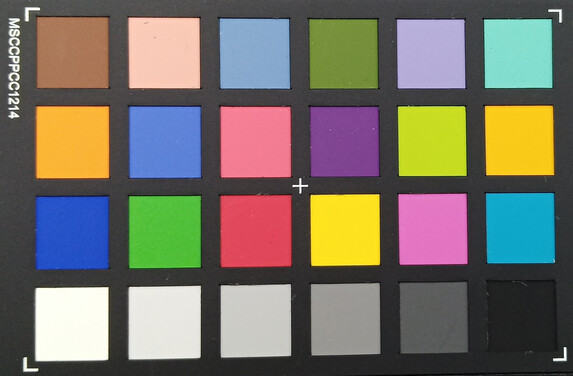
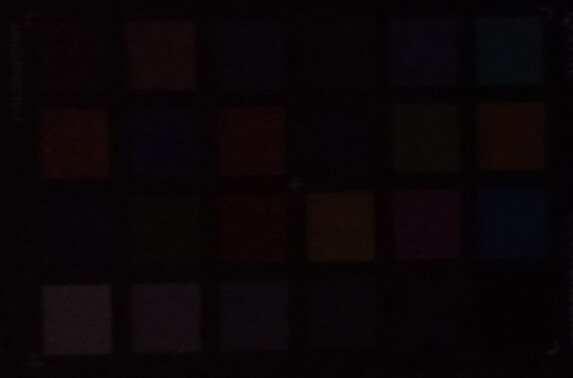
Display - The AMOLED in the carbon smartphone is dark
Unfortunately, the AMOLED screen is not convincing in terms of brightness: It also looks like from another era and only has an average brightness of 336 cd/m². That is partly only half or even less than what the competing phones can achieve in bright ambient light.
The color reproduction is also rather moderately accurate. There is no option to adjust the white balance and other parameters ex-works. However, the screen looks quite sharp.
Since it is an AMOLED screen, there is also the usual PWM flickering as soon as you lower the brightness. Therefore, sensitive people should try the screen before buying it.
| |||||||||||||||||||||||||
Brightness Distribution: 95 %
Center on Battery: 336 cd/m²
Contrast: ∞:1 (Black: 0 cd/m²)
ΔE ColorChecker Calman: 7.14 | ∀{0.5-29.43 Ø4.77}
ΔE Greyscale Calman: 3.7 | ∀{0.09-98 Ø5}
142.8% sRGB (Calman 2D)
Gamma: 2.04
CCT: 7192 K
| Carbon 1 Mk II AMOLED, 2160x1080, 6" | Apple iPhone 12 OLED, 2532x1170, 6.1" | Samsung Galaxy S21 Dynamic AMOLED 2X, 2400x1080, 6.2" | Sony Xperia 5 II OLED, 2520x1080, 6.1" | |
|---|---|---|---|---|
| Response Times | -60% | 36% | 20% | |
| Response Time Grey 50% / Grey 80% * (ms) | 10 ? | 10 ? -0% | 9.6 ? 4% | 8 ? 20% |
| Response Time Black / White * (ms) | 10 ? | 22 ? -120% | 3.2 ? 68% | 8 ? 20% |
| PWM Frequency (Hz) | 255.1 | 226.2 | 240.4 ? | 238.1 |
| Screen | 71% | 77% | 50% | |
| Brightness middle (cd/m²) | 336 | 642 91% | 790 135% | 558 66% |
| Brightness (cd/m²) | 336 | 639 90% | 793 136% | 562 67% |
| Brightness Distribution (%) | 95 | 97 2% | 97 2% | 98 3% |
| Black Level * (cd/m²) | ||||
| Colorchecker dE 2000 * | 7.14 | 0.9 87% | 2.2 69% | 3.01 58% |
| Colorchecker dE 2000 max. * | 11.68 | 2.42 79% | 4.2 64% | 6.86 41% |
| Greyscale dE 2000 * | 3.7 | 0.8 78% | 1.6 57% | 1.4 62% |
| Gamma | 2.04 108% | 2.188 101% | 2.13 103% | 2.196 100% |
| CCT | 7192 90% | 6404 101% | 6497 100% | 6398 102% |
| Total Average (Program / Settings) | 6% /
38% | 57% /
67% | 35% /
42% |
* ... smaller is better
Display Response Times
| ↔ Response Time Black to White | ||
|---|---|---|
| 10 ms ... rise ↗ and fall ↘ combined | ↗ 5 ms rise | |
| ↘ 5 ms fall | ||
| The screen shows good response rates in our tests, but may be too slow for competitive gamers. In comparison, all tested devices range from 0.1 (minimum) to 240 (maximum) ms. » 26 % of all devices are better. This means that the measured response time is better than the average of all tested devices (20.2 ms). | ||
| ↔ Response Time 50% Grey to 80% Grey | ||
| 10 ms ... rise ↗ and fall ↘ combined | ↗ 5 ms rise | |
| ↘ 5 ms fall | ||
| The screen shows good response rates in our tests, but may be too slow for competitive gamers. In comparison, all tested devices range from 0.165 (minimum) to 636 (maximum) ms. » 22 % of all devices are better. This means that the measured response time is better than the average of all tested devices (31.6 ms). | ||
Screen Flickering / PWM (Pulse-Width Modulation)
| Screen flickering / PWM detected | 255.1 Hz | ||
The display backlight flickers at 255.1 Hz (worst case, e.g., utilizing PWM) . The frequency of 255.1 Hz is relatively high, so most users sensitive to PWM should not notice any flickering. However, there are reports that some users are still sensitive to PWM at 500 Hz and above, so be aware. In comparison: 53 % of all tested devices do not use PWM to dim the display. If PWM was detected, an average of 8084 (minimum: 5 - maximum: 343500) Hz was measured. | |||
Performance, emissions and battery life - Warm-sounding sound
The Carbon 1 Mk II is equipped with a MediaTek Helio P90 it is an upper mid-range SoC that you would rather expect in a smartphone for 300 - 500 Euros. Thus, the performance cannot keep up with any of the comparison devices, which is especially visible in the graphics performance.
The smartphone is usually reasonably fast in everyday use, but the perceived speed is also much lower than in current high-end smartphones because the screen only has a 60 Hz display
The smartphone heats up quite a bit with up to 46.6 °C in some places. This warming is clearly noticeable, but only selectively so strong and also bearable in normal ambient conditions. The smartphone should be handled carefully during heavy load on hot days.
The mono speaker sounds quite decent, it does not overdrive and even produces a reasonably warm sound. You do not get stereo sound here, but it is a good speaker for occasional use. If you want to connect 3.5 mm headphones, you have to use an adapter for the USB-C port. Otherwise, external audio devices can also be connected via Bluetooth, and both work without problems.
The battery is relatively weak with 3000 mAh, but the quite small display still allows decent runtimes of 10:32 hours. You should be able to survive a day without recharging the battery. The iPhone 12 offers another 50% more stamina with an even slightly weaker battery. You should plan about 100 minutes for charging when the battery is very low.
| PCMark for Android - Work 2.0 performance score (sort by value) | |
| Carbon 1 Mk II | |
| Samsung Galaxy S21 | |
| Sony Xperia 5 II | |
| Average Mediatek Helio P90 (7129 - 9654, n=3) | |
| GFXBench | |
| on screen Aztec Ruins Normal Tier Onscreen (sort by value) | |
| Carbon 1 Mk II | |
| Apple iPhone 12 | |
| Samsung Galaxy S21 | |
| Sony Xperia 5 II | |
| Average Mediatek Helio P90 (6.5 - 9.3, n=3) | |
| Average of class Smartphone (6.2 - 166, n=210, last 2 years) | |
| 1920x1080 Aztec Ruins Normal Tier Offscreen (sort by value) | |
| Carbon 1 Mk II | |
| Apple iPhone 12 | |
| Samsung Galaxy S21 | |
| Sony Xperia 5 II | |
| Average Mediatek Helio P90 (6.4 - 11, n=3) | |
| Average of class Smartphone (3.4 - 367, n=210, last 2 years) | |
| on screen Aztec Ruins High Tier Onscreen (sort by value) | |
| Carbon 1 Mk II | |
| Apple iPhone 12 | |
| Samsung Galaxy S21 | |
| Sony Xperia 5 II | |
| Average Mediatek Helio P90 (3.5 - 5.8, n=3) | |
| Average of class Smartphone (0.85 - 144, n=211, last 2 years) | |
| 2560x1440 Aztec Ruins High Tier Offscreen (sort by value) | |
| Carbon 1 Mk II | |
| Apple iPhone 12 | |
| Samsung Galaxy S21 | |
| Sony Xperia 5 II | |
| Average Mediatek Helio P90 (2.4 - 4.3, n=3) | |
| Average of class Smartphone (1.2 - 146, n=210, last 2 years) | |
| Carbon 1 Mk II | Samsung Galaxy S21 | Sony Xperia 5 II | Average 256 GB UFS 2.1 Flash | Average of class Smartphone | |
|---|---|---|---|---|---|
| AndroBench 3-5 | 471% | 217% | 171% | 652% | |
| Sequential Read 256KB (MB/s) | 496 | 1648 232% | 1445 191% | 829 ? 67% | 2253 ? 354% |
| Sequential Write 256KB (MB/s) | 207 | 1095 429% | 229.5 11% | 376 ? 82% | 1878 ? 807% |
| Random Read 4KB (MB/s) | 108.4 | 309.7 186% | 187.3 73% | 168.8 ? 56% | 298 ? 175% |
| Random Write 4KB (MB/s) | 24.9 | 282.6 1035% | 172.6 593% | 143.6 ? 477% | 342 ? 1273% |
Temperature
(-) The maximum temperature on the upper side is 46.6 °C / 116 F, compared to the average of 35.2 °C / 95 F, ranging from 21.9 to 247 °C for the class Smartphone.
(-) The bottom heats up to a maximum of 46.3 °C / 115 F, compared to the average of 34 °C / 93 F
(+) In idle usage, the average temperature for the upper side is 26.5 °C / 80 F, compared to the device average of 32.9 °C / 91 F.
Loudspeaker
Carbon 1 Mk II audio analysis
(+) | speakers can play relatively loud (82.3 dB)
Bass 100 - 315 Hz
(-) | nearly no bass - on average 29% lower than median
(±) | linearity of bass is average (9.5% delta to prev. frequency)
Mids 400 - 2000 Hz
(±) | higher mids - on average 5.2% higher than median
(+) | mids are linear (6.4% delta to prev. frequency)
Highs 2 - 16 kHz
(±) | higher highs - on average 5% higher than median
(+) | highs are linear (6.6% delta to prev. frequency)
Overall 100 - 16.000 Hz
(±) | linearity of overall sound is average (24.3% difference to median)
Compared to same class
» 57% of all tested devices in this class were better, 7% similar, 36% worse
» The best had a delta of 11%, average was 35%, worst was 134%
Compared to all devices tested
» 73% of all tested devices were better, 6% similar, 21% worse
» The best had a delta of 4%, average was 24%, worst was 134%
Apple iPhone 12 audio analysis
(±) | speaker loudness is average but good (81.1 dB)
Bass 100 - 315 Hz
(-) | nearly no bass - on average 62.2% lower than median
(+) | bass is linear (0% delta to prev. frequency)
Mids 400 - 2000 Hz
(-) | nearly no mids - on average 62.2% lower than median
(+) | mids are linear (0% delta to prev. frequency)
Highs 2 - 16 kHz
(-) | nearly no highs - on average 62.2% lower than median
(+) | highs are linear (0% delta to prev. frequency)
Overall 100 - 16.000 Hz
(-) | overall sound is not linear (123.1% difference to median)
Compared to same class
» 92% of all tested devices in this class were better, 7% similar, 1% worse
» The best had a delta of 11%, average was 35%, worst was 134%
Compared to all devices tested
» 97% of all tested devices were better, 2% similar, 0% worse
» The best had a delta of 4%, average was 24%, worst was 134%
Battery life
| Carbon 1 Mk II 3000 mAh | Apple iPhone 12 2815 mAh | Samsung Galaxy S21 4000 mAh | Sony Xperia 5 II 4000 mAh | Average of class Smartphone | |
|---|---|---|---|---|---|
| Battery Runtime | |||||
| WiFi Websurfing (h) | 10.5 | 15.8 50% | 9.1 -13% | 13.2 26% | 19.2 ? 83% |
Pros
Cons
Verdict - The pioneer smartphone
The Carbon 1 Mk II feels a bit like a prototype, as we mentioned at the beginning: Due to the long development time, battery life, performance, screen brightness, camera and storage speed lag far behind other smartphones in the upper class. Thus, those who expect top performance are wrong.
However, those who are looking for a light, stable smartphone without rounded corners are in the right place. Especially if he or she is willing to pay a bit more for modern materials and an individual smartphone that not everyone has.
The Carbon 1 Mk II is a technologically highly interesting smartphone. However, it only offers mediocre features at a high price in everyday use.
Unfortunately, you have to deal with many small annoyances, such as the strange fingerprint sensor and the not yet available Android 11. However, there are also positive aspects, such as the ample memory and the better recycling properties compared to conventional smartphones.
Overall, not a smartphone that will conquer the mass market at the issue price, but certainly worth a look for individualists and technology enthusiasts. If the prices drop, Carbon's first smartphone could also become interesting for other groups.
Price and availability
The innovative Carbon 1 Mk II is still quite close to the manufacturer's price of 799 Euros at the time of testing. Many online retailers have it in their program, including amazon.de.
Carbon 1 Mk II
- 08/31/2022 v7 (old)
Florian Schmitt





